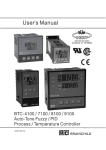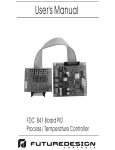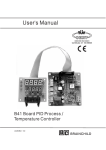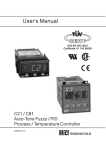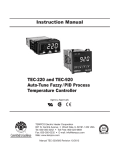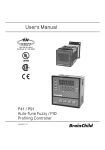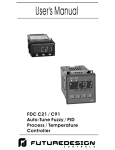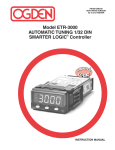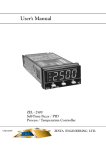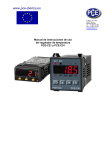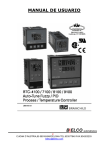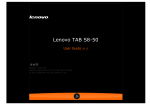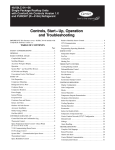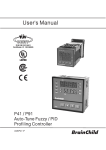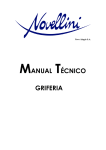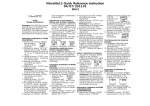Download ZEL-9100 User Manual - Zesta Engineering Ltd.
Transcript
User's Manual DIN EN ISO 9001 Certificate: 01 100 98505 R ZEL-4100 / 7100 / 8100 / 9100 Auto-Tune Fuzzy / PID Process / Temperature Controller UM91001D ZESTA ENGINEERING LTD. Warning Symbol The Symbol calls attention to an operating procedure, practice, or the like, which, if not correctly performed or adhered to, could result in personal injury or damage to or destruction of part or all of the product and system. Do not proceed beyond a warning symbol until the indicated conditions are fully understood and met. Use the Manual Installers Read Chapter 1, 2 System Designer Read All Chapters Expert User Read Page 12 NOTE: It is strongly recommended that a process should incorporate a LIMIT CONTROL like L91 which will shut down the equipment at a preset process condition in order to preclude possible damage to products or system. Information in this user's manual is subject to change without notice. This manual is applicable for the products with software version 23 and later version. Copyright February 2002, ZESTA ENGINEERING LTD, all rights reserved. No part of this publication may be reproduced, transmitted, transcribed or stored in a retrieval system, or translated into any language in any form by any means without the written permission of ZESTA ENGINEERING LTD. 2 UM91001D Contents Page No Page No Chapter 1 Overview Chapter 4 Applications 1-1 General ------------------------- 5 1-2 Ordering Code --------------- 8 1-3 Programming Port ------------ 9 1-4 Keys and Displays --------- 10 1-5 Menu Overview ------------- 12 1-6 Parameter Descriptions ---- 13 4-1 Heat Only Control with Dwell Timer ---- 51 4-2 Cool Only Control ------------------------- 52 4-3 Heat-Cool Control ------------------------- 53 Chapter 5 Chapter 2 Installation 2-1 Unpaking ------------------------- 20 2-2 Mounting ------------------------- 20 2-3 Wiring precautions --------- 22 2-4 Power Wiring ----------------- 25 2-5 Sensor Installation Guidlines — 25 2-6 Sensor Input Wiring ------- 26 2-7 Control Output Wiring ----- 26 2-8 Alarm Wiring ----------------- 30 2-9 Data Communication ------ 31 Chapter 3 Programming 3-1 Lockout ------------------------ 33 3-2 Signal Input ------------------- 33 3-3 Control Outputs -------------- 34 3-4 Alarm --------------------------- 39 3-5 Configure User Menu ------- 40 3-6 Ramp --------------------------- 41 3-7 Dwell Timer ------------------- 42 3-8 PV Shift ------------------------ 43 3-9 Digital Filter ------------------- 44 3-10 Failure Transfer ------------- 45 3-11 Auto-tuning ------------------ 46 3-12 Manual tuning --------------- 47 3-13 Manual Control ------------- 48 3-14 Data Communication ---- 50 3-15 PV Retransmission ------- 50 Calibration -------- 55 Chapter 6 Specifications ---- 60 Chapter 7 Modbus Communications ---- 66 7-1 7-2 7-3 7-4 7-5 Functions Supporte --------------------------Exception Responses ------------------------Parameter Table --------------------------Data Conversion --------------------------Communication Examples ----------------- 66 68 69 73 73 Appendix A-1 Error Codes ------------------ 76 A-2 Warranty ---------------------- 77 UM91001A 3 Figures & Tables Page No Figure 1.1 Fuzzy Control Advantage ---------------------------------------------------------------- 6 Figure 1.2 Programming Port Overview ------------------------------------------------------------ 9 Figure 1.3 Front Panel Description ----------------------------------------------------------------- 11 Figure 1.4 Display of Initial Stage ------------------------------------------------------------------- 11 Figure 2.1 Mounting Dimensions ------------------------------------------------------------------- 21 Figure 2.2 Lead Termination for ZEL - 4100, ZEL - 8100 and ZEL - 7100 ------------- 23 Figure 2.3 Lead Termination for ZEL - 9100 ------------------------------------------------------- 23 Figure 2.4 Rear Terminal Connection for ZEL - 4100 and ZEL - 8100 --------------------- 23 Figure 2.5 Rear Terminal Connection for ZEL - 7100 -------------------------------------------- 24 Figure 2.6 Rear Terminal Connection for ZEL - 9100 -------------------------------------------- 24 Figure 2.7 Power Supply Connections ------------------------------------------------------------ 25 Figure 2.8 Sensor Input Wiring ---------------------------------------------------------------------- 26 Figure 2.9 Output 1 Relay or Triac (SSR) to Drive Load --------------------------------------- 26 Figure 2.10 Output 1 Relay or Triac (SSR) to Drive Contactor ------------------------------- 27 Figure 2.11 Output 1 Pulsed Voltage to Drive SSR --------------------------------------------- 27 Figure 2.12 Output 1 Linear Current --------------------------------------------------------------- 28 Figure 2.13 Output 1 Linear Voltage --------------------------------------------------------------- 28 Figure 2.14 Output 2 Relay or Triac (SSR) to Drive Load ------------------------------------- 28 Figure 2.15 Output 2 Relay or Triac (SSR) to Drive Contactor ------------------------------- 29 Figure 2.16 Output 2 Pulsed Voltage to Drive SSR --------------------------------------------- 29 Figure 2.17 Output 2 Linear Current --------------------------------------------------------------- 29 Figure 2.18 Output 2 Linear Voltage -------------------------------------------------------------- 30 Figure 2.19 Alarm Output to Drive Load ---------------------------------------------------------- 30 Figure 2.20 Alarm Output to Drive Contactor ---------------------------------------------------- 30 Figure 2.21 RS-485 Wiring --------------------------------------------------------------------------- 31 Figure 2.22 RS-232 Wiring --------------------------------------------------------------------------- 32 Figure 2.23 Configuration of RS-232 Cable ------------------------------------------------------ 32 Figure 3.1 Conversion Curve for Linear Type Process Value --------------------------------- 34 Figure 3.2 Heat Only ON-OFF Control ------------------------------------------------------------ 35 Figure 3.3 Output 2 Deviation High Alarm -------------------------------------------------------- 38 Figure 3.4 Output 2 Process Low Alarm ---------------------------------------------------------- 38 Figure 3.5 RAMP Function --------------------------------------------------------------------------- 41 Figure 3.6 Dwell Timer Function -------------------------------------------------------------------- 42 Figure 3.7 PV Shift Application ---------------------------------------------------------------------- 43 Figure 3.8 Filter Characteristics --------------------------------------------------------------------- 44 Figure 3.9 Effects of PID Adjustment ------------------------------------------------------------- 49 Figure 4.1 Heat Control Example ------------------------------------------------------------------- 51 Figure 4.2 Cooling Control Example --------------------------------------------------------------- 52 Figure 4.3 Heat-Cool Control Example ------------------------------------------------------------ 53 Figure 5.1 RTD Calibration --------------------------------------------------------------------------- 57 Figure 5.2 Cold Junction Calibration Setup ------------------------------------------------------ 58 Table 1.1 Display Form of Characters -----------------------------------------------------------Table 3.1 Heat-Cool Control Setup Value --------------------------------------------------------Table 3.2 PID Adjustment Guide -------------------------------------------------------------------Table A.1 Error Codes and Corrective Actions -------------------------------------------------- 4 UM91001A 11 34 48 66 Chapter 1 Overview 1 - 1 General The Fuzzy Logic plus PID microprocessor-based controller series, incorporate two bright, easy to read 4-digit LED displays, indicating process value and set point value. The Fuzzy Logic technology enables a process to reach a predetermined set point in the shortest time, with the minimum of overshoot during power-up or external load disturbance. ZEL - 9100 is a 1/16 DIN size panel mount controller. It can also be used for rail mount by adding a rail mount kit . ZEL - 7100 is a 72X72 DIN size panel mount controller. ZEL - 8100 is a 1/8 DIN size panel mount controller and ZEL - 4100 is a 1/4 DIN size panel mount controller. These units are powered by 11-26 or 90-250 VDC /VAC supply, incorporating a 2 amp. control relay output as standard. The second output can be used as cooling control, or an alarm. Both outputs can select triac, 5V logic output, linear current or linear voltage to drive external device. There are six types of alarm plus a dwell timer can be configured for the third output.The units are fully programmable for PT100 and thermocouple types J, K, T, E, B, R, S, N, L with no need to modify the unit. The input signal is digitized by using a 18-bit A to D converter. Its fast sampling rate allows the unit to control fast processes. Digital communications RS-485 or RS-232 ( excluding ZEL - 7100 ) are available as an additional option. These options allow the units to be integrated with supervisory control system and software. A programming port is available for automatic configuration, calibration and testing without the need to access the keys on front panel. By using proprietary Fuzzy modified PID technology, the control loop will minimize the overshoot and undershoot in a shortest time. The following diagram is a comparison of results with and without Fuzzy technology. UM91001B 5 PID control with properly tuned PID + Fuzzy control Temperature Set point Figure 1.1 Fuzzy Control Advantage Warm Up Load Disturbance Time High Accuracy The series are manufactured with custom designed ASIC(Application Specific Integrated Circuit ) technology which contains a 18-bit A to D converter for high resolution measurement ( true 0.1 BF resolution for thermocouple and PT100 ) and a 15-bit D to A converter for linear current or voltage control output. The ASIC technology provides improved operating performance, low cost, enhanced reliability and higher density. Fast Sampling Rate The sampling rate of the input A to D converter reaches 5 times/second. The fast sampling rate allows this series to control fast processes. Fuzzy Control The function of Fuzzy control is to adjust PID parameters from time to time in order to make manipulation output value more flexible and adaptive to various processes. The results is to enable a process to reach a predetermined set point in the shortest time, with the minimum of overshoot and undershoot during power-up or external load disturbance. Digital Communication The units are equipped with RS-485 or RS-232 interface card to provide digital communication. By using the twisted pair wires there are at most 247 units can be connected together via RS-485 interface to a host computer. 6 UM91001A Programming Port A programming port is used to connect the unit to a hand-held programmer or a PC for quick configuration, also can be connected to an ATE system for automatic testing & calibration. Auto-tune The auto-tune function allows the user to simplify initial setup for a new system. A clever algorithm is provided to obtain an optimal set of control parameters for the process, and it can be applied either as the process is warming up ( cold start ) or as the process has been in steady state ( warm start ). Lockout Protection According to actual security requirement, one of four lockout levels can be selected to prevent the unit from being changed abnormally. Bumpless Transfer Bumpless transfer allows the controller to continue to control by using its previous value as the sensor breaks. Hence, the process can be well controlled temporarily as if the sensor is normal. Soft-start Ramp The ramping function is performed during power up as well as any time the set point is changed. It can be ramping up or ramping down. The process value will reach the set point with a predetermined constant rate. Digital Filter A first order low pass filter with a programmable time constant is used to improve the stability of process value. This is particularly useful in certain application where the process value is too unstable to be read. SEL Function The units have the flexibility for user to select those parameters which are most significant to him and put these parameters in the front of display sequence. There are at most 8 parameters can be selected to allow the user to build his own display sequence. UM91001A 7 1 - 2 Ordering Code ZEL - 4100 ZEL - 7100 ZEL - 8100 ZEL - 9100 - Power Input 4: 90 - 250 VAC, 50/60 HZ 5: 11 - 26 VAC or VDC 9: Special Order Signal Input 1: Standard Input Thermocouple: J, K, T, E, B, R, S, N, L RTD: PT100 DIN, PT100 JIS 2: 0 - 60 mV 3: 0 -1 V 4: 0 - 5 V 5: 1 - 5 V 6: 4 - 20 mA 7: 0 - 20 mA 8: 0 - 10 V 9: Special Order Output 1 0: None 1: Relay rated 2A/240VAC 2: Pulsed voltage to drive SSR, 5V/30mA 3: Isolated 4 - 20mA / 0 - 20mA 4: Isolated 1 - 5V / 0 - 5V 5: Isolated 0 - 10V 6: Triac output 1A / 240VAC,SSR C: Pulsed voltage to drive SSR, 14V/40mA 9: Special order 8 Options 0: Panel mount IP50 standard 1: Panel mount IP65 water resistant rubber installed 2: DIN Rail mount with IP50 (for ZEL - 9100 only) 3: DIN Rail mount with IP65 (for ZEL - 9100 only) Communications 0: None 1: RS-485 interface 2: RS-232 interface ( not available for ZEL - 7100 ) 3: Retransmit 4-20mA / 0-20mA 4: Retransmit 1-5 V / 0-5V 5: Retransmit 0-10V 9: Special order Alarm 0: None 1: Form C relay 2A/240VAC 9: Special order Output 2 0: None 1: Form A relay 2A/240VAC 2: Pulsed voltage to drive SSR, 5V / 30mA 3: Isolated 4 - 20mA / 0 - 20mA 4: Isolated 1 - 5V / 0 - 5V 5: Isolated 0 - 10V 6: Triac output, 1A / 240VAC, SSR 7: Isolated 20V/25mA transducer power supply 8: Isolated 12V/40mA transducer power supply 9: Isolated 5V/80mA transducer power supply C: Pulsed voltage to drive SSR, 14V/40mA A: Special order UM91001C Accessories OM94-6 = Isolated 1A / 240VAC Triac Output Module ( SSR ) OM94-7 = 14V / 40mA SSR Drive Module OM96-3 = Isolated 4 - 20 mA / 0 - 20 mA Analog Output Module OM96-4 = Isolated 1 - 5V / 0 - 5V Analog Output Module OM96-5 = Isolated 0 -10V Analog Output Module CM94-1 = Isolated RS-485 Interface Module for ZEL - 8100/4100/7100 CM94-2 = Isolated RS-232 Interface Module for ZEL - 8100/4100 CM94-3 = Isolated 4 - 20 mA / 0 - 20 mA Retrans Module for ZEL - 8100/4100/7100 CM94-4 = Isolated 1 - 5V / 0 - 5V Retrans Module for ZEL - 8100, ZEL - 4100 , ZEL - 7100 CM94-5 = Isolated 0-10V Retrans Module for ZEL - 8100/4100/7100 CM97-1 = Isolated RS-485 Interface Module for ZEL - 9100 CM97-2 = Isolated RS-232 Interface Module for ZEL - 9100 CM97-3 = Isolated 4-20 mA / 0-20mA Retrans Module for ZEL - 9100 CM97-4 = Isolated 1-5V / 0-5V Retrans Module for ZEL - 9100 CM97-5 = Isolated 0-10V Retrans Module for ZEL - 9100 DC94-1 = Isolated 20V/25mA DC Output Power Supply DC94-2 = Isolated 12V/40mA DC Output Power Supply DC94-3 = Isolated 5V/80mA DC Output Power Supply CC94-1 = RS-232 Interface Cable ( 2M ) CC91-1 = Programming Port Cable RK91-1 = Rail Mount kit for ZEL - 9100 Related Products SNA10A = Smart Network Adaptor for third party software, which converts 255 channels of RS-485 or RS-422 to RS-232 Network. SNA10B = Smart Network Adaptor for ZE - Net software, which converts 255 channels of RS-485 or RS-422 to RS-232 network. SNA12A = Smart Network Adapter for programming port to RS-232 interface ZE - Set = Configuration Software UM91001C 8-1 1 - 3 Programming Port Front Panel Rear Terminal 6 4 2 Figure 1.2 Programming Port Overview 5 3 1 Access Hole 6 4 2 5 3 1 A special connector can be used to touch the programming port which is connected to a PC for automatic configuration, also can be connected to an ATE system for automatic calibration and testing. The programming port is used for off-line automatic setup and testing procedures only. Don't attempt to make any connection to these pins when the unit is used for a normal control purpose. 9 UM91001A 1 - 4 Keys and Displays KEYPAD OPERATION SCROLL KEY : This key is used to select a parameter to be viewed or adjusted. UP KEY : This key is used to increase the value of selected parameter. DOWN KEY : This key is used to decrease the value of selected parameter. RESET KEY : R This key is used to: 1. Revert the display to display the process value. 2. Reset the latching alarm, once the alarm condition is removed. 3. Stop the manual control mode , auto-tuning mode and calibration mode. 4. Clear the message of communication error and auto-tuning error. 5. Restart the dwell timer when the dwell timer has been time out. 6. Enter the manual control menu during failure mode occurs. ENTER KEY : Press for 5 seconds or longer . Press for 5 seconds to: 1. Ener setup menu. The display shows . 2. Enter manual control mode during manual control mode is selected. 3. Enter auto-tuning mode during auto-tuning mode selected. is 4. Perform calibration to a selected parameter during the calibration procedure. Press for 6.2 seconds to select manual control mode. Press for 7.4 seconds to select auto-tuning mode. Press for 8.6 seconds to select calibration mode. UM91001D 10 Alarm Indicator Upper Display, to display process value, menu symbol and error code etc. Process Unit Indicator Output 2 Indicator OP1 OP2 ALM Output 1 Indicator C Manual Mode Indicator F Lower Display, to display set point value, parameter value or control output value etc. MAN AT Auto-tuning Indicator R ZEL - 9100 ZESTA Figure 1.3 4 Buttons for ease of control setup and set point adjustment. Front Panel Description Table 1.1 Display Form of Characters A B C E F G H h c D I J K L M N O P Q R S T U V W X Y Z ? = : Confused Character OP1 OP2 ALM C F The left diagram shows program no. 6 for ZEL - 9100 with version 24. The program no. for ZEL - 7100 is 13, for ZEL - 8100 is 11 and for ZEL - 4100 is 12. MAN AT R ZESTA 11 Display program code of the product for 2.5 seconds. Figure 1.4 Display of Initial Stage ZEL - 9100 UM91001D 1 - 5 Menu Overview User menu Manual Mode Setup menu 7.4 sec. 6.2 sec. 5 sec. Auto-tuning Mode Calibration Mode 8.6 sec. 9.8 sec. PV, SV *2 SP2 SP3 INPT UNIT DP PB TI TD CYC1 ADDR *1 LOCK INPT UNIT DP INLO INHI SP1L SP1H SHIF FILT PB TI TD OUT1 O1TY O1FT O1HY CYC1 OFST RAMP RR OUT2 O2TY O2FT O2HY CYC2 CPB DB ALFN ALMD ALHY ALFT COMM ADDR BAUD DATA PARI STOP RELO REHI SEL1 SEL2 SEL3 SEL4 SEL5 SEL6 SEL7 SEL8 H_ _ _ C_ _ _ Press for 5 seconds to start manual control. Release then press for 5 seconds to start auto-tuning mode. *3 ADLO ADHI RTDL RTDH CJLO CJHI Press for 5 seconds to perform calibration. Apply these modes will break the control loop and change some of the previous setting data. Make sure that if the system is allowable to apply these modes. *1: The flow chart shows a complete listing of all parameters. For actual application the number of available parameters depends on setup conditions, and should be less than that shown in the flow chart. *2: You can select at most 8 parameters put in the user menu by using SEL1~SEL8 contained at the bottom of setup menu. *3: Release , press again for 2 seconds or longer (but not longer than 3 seconds), then release to enter the calibration menu. The user menu shown in the flow chart is corresponding to the default setting for the SEL parameters SEL1 to SEL8. SP3 will be hidden if NONE is selected for ALFN. SP2 will be hidden if alarm function is not selected for OUT2. The unused parameter will be hidden even if it is selected by SEL parameters. UM91001D 12 1 - 6 Parameter Descriptions Parameter Notation Range Parameter Description SP1 Set point for output 1 Low: SP1L SP2 Set point for output 2 when output 2 performs alarm function Low: -19999 High :45536 10.0 BC (18.0BF) SP3 Set point for alarm or dwell timer output Low: -19999 High: 45536 10.0 BC (18.0 BF) 0 LOCK Select parameters to be locked 1 2 3 2 3 : E type thermocouple 4 5 : B type thermocouple : R type thermocouple 6 : S type thermocouple 7 : N type thermocouple 8 : L type thermocouple 9 : PT 100 ohms DIN curve : PT 100 ohms JIS curve : 4 - 20 mA linear current input : 0 - 20 mA linear current input : 0 - 60 mV linear millivolt input : 0 - 1V linear voltage input : 0 - 5V linear voltage input : 1 - 5V linear voltage input : 0 - 10V linear voltage input 1 Input sensor selection 10 11 12 13 14 15 16 17 13 : No parameter is locked : Setup data are locked : Setup data and User data except Set point are locked : All data are locked : J type thermocouple : K type thermocouple : T type thermocouple 0 INPT High :SP1H Default Value 25.0 BC (77.0BF) UM91001A 0 1 (0) Parameter Notation UNIT DP Parameter Description Input unit selection Decimal point selection Default Value Range 0 : Degree C unit 1 : Degree F unit 2 : Process unit 0 : No decimal point 1 : 1 decimal digit 2 : 2 decimal digits 3 : 3 decimal digits 0 (1) 1 -17.8 LC ( 0 LF ) 93.3 LC (200.0 LF) INLO Input low sale value Low: -19999 High: 45486 INHI Input high scale value Low: INLO+50 High: 45536 SP1L Low limit of set point value Low: -19999 High: 45536 -17.8 LC (0 LF) High: 45536 537.8 LC (1000 LF) High: 200.0 LC ( 360.0 LF) 0.0 SP1H High limit of set point value SHIF PV shift (offset) value Low: SP1L -200.0 LC Low: (-360.0 LF) 0 1 2 3 4 FILT Filter damping time constant of PV 5 6 7 8 9 UM91001A : 0 second time constant : 0.2 second time constant : 0.5 second time constant : 1 second time constant : 2 seconds time constant : 5 seconds time constant : 10 seconds time constant : 20 seconds time constant : 30 seconds time constant : 60 seconds time constant 2 14 Parameter Notation Parameter Description Range High: 500.0 LC (900.0 LF) Default Value 10.0 LC (18.0 LF) PB Proportional band value Low: 0 TI Integral time value Low: 0 High: 1000 sec 100 TD Derivative time value Low: 0 High: 360.0 sec 25.0 0 OUT1 Output 1 function 1 : Reverse (heating ) control action : Direct (cooling) control action 0 : Relay output 1 : Solid state relay drive output 2 : Solid state relay output 3 : 4-20 mA current module O1TY Output 1 signal type O1FT Output 1 failure transfer mode O1HY Output 1 ON-OFF control hysteresis Low: 0.1 High: 50.0 BC(90.0BF) CYC1 Output 1 cycle time Low: 0.1 High: 90.0 sec. OFST Offset value for P control Low: 0 High: 100.0 % 0 : No Ramp Function 1 : Use unit/minute as Ramp Rate : Use unit/hour as Ramp Rate RAMP Ramp function selection : 0 - 20 mA current module : 0 - 1V voltage 5 module : 0 - 5V voltage 6 module : 1 - 5V voltage 7 module : 0 - 10V voltage 8 module Select BPLS ( bumpless transfer ) or 0.0 ~ 100.0 % to continue output 1 control function as the unit fails, or select OFF (0) or ON (1) for ON-OFF control. 4 2 15 UM91001A 0 0 0 0.1LC (0.2LF) 18.0 25.0 0 Parameter Notation RR Ramp rate Low: 0 0 OUT2 Output 2 function : Deviation High Alarm 6 : Process High Alarm 7 : Process Low Alarm 8 : Cooling PID Function 0 : Relay output 1 : Solid state relay drive output : Solid state relay output : 4 - 20 mA current module : 0 - 20 mA current module : 0 - 1V voltage module : 0 - 5V voltage module : 1 - 5V voltage module : 0 - 10V voltage module 4 6 7 8 Output 2 failure transfer mode 0.0 : Output 2 No Function : Deviation Low Alarm 5 O2FT 500.0 LC (900.0 LF) 3 3 Output 2 signal type High: 2 2 O2TY Default Value Range Parameter Description Select BPLS ( bumpless transfer ) or 0.0 ~ 100.0 % to continue output 2 control function as the unit fails, or select ON (0) or OFF (1) for alarm function. 2 0 0 O2HY Output 2 hysteresis value when output 2 performs alarm function Low: 0.1 CYC2 Output 2 cycle time Low: 0.1 High: 90.0 sec. 18.0 CPB Cooling proportional band value Low: 50 High: 300 % 100 UM91001A High: 50.0 LC (90.0 LF) 0.1 LC (0.2 LF) 16 Parameter Notation DB ALFN Parameter Description Range Heating-cooling dead band (negative value= overlap) Alarm function for alarm output Low: -36.0 0 :No alarm function 1 :Dwell timer action 2 :Deviation high alarm 3 :Deviation low alarm 4 :Deviation band out of band alarm :Deviation band in band alarm :Process value high alarm :Process value low alarm 5 6 7 0 ALMD 1 Alarm operation mode 2 3 ALHY Hysteresis control of alarm ALFT Alarm failure transfer mode Low: 0.1 0 1 0 1 2 COMM Communication function 3 4 5 6 17 High: 36.0 % UM91001D : Normal alarm action : Latching alarm action : Hold alarm action Latching & Hold : action High: 50.0 LC (90.0 LF) : Alarm output ON as unit fails : Alarm output OFF as unit fails : No communication Default Value 0 2 0 0.1 LC (0.2 LF) 0 : Modbus RTU mode protocol :4-20mA retransmission output :0-20mA retransmission output :0-5V retransmission output :1-5V retransmission output :0-10V retransmission output 1 Parameter Notation ADDR BAUD Parameter Description Address assignment of digital communication Baud rate of digital communication Range Low: 1 Default Value High: 255 0 : 2.4 Kbits/s baud rate 1 : 4.8 Kbits/s baud rate 2 : 9.6 Kbits/s baud rate 3 : 14.4 Kbits/s baud rate 4 : 19.2 Kbits/s baud rate 5 : 28.8 Kbits/s baud rate 6 : 38.4 Kbits/s baud rate 2 DATA Data bit count of digital communication 0 1 : 7 data bits : 8 data bits 1 PARI Parity bit of digital communication 0 1 2 : Even parity : Odd parity : No parity bit 0 STOP Stop bit count of digital communication 0 1 RELO Retransmission low scale value Low: -19999 High: 45536 0.0 LC (32.0 LF) REHI Retransmission high scale value Low: -19999 High: 45536 100.0 LC (212.0 LF) SEL1 Select 1'st parameter for user menu : One stop bit : Two stop bits 0 : No parameter selected 1 : LOCK is put ahead 2 : INPT is put ahead 3 : UNIT is put ahead 4 : DP is put ahead 5 : SHIF is put ahead 6 : PB is put ahead 7 : TI is put ahead UM91001D 0 2 18 Prameter Notation SEL1 Parameter Description Select 1'st parameter for user menu Range 8 : TD is put ahead 9 : O1HY is put ahead 10 : CYC1 is put ahead 11 : OFST is put ahead 12 : RR is put ahead 13 : O2HY is put ahead 14 : CYC2 is put ahead 15 : CPB is put ahead 16 : DB is put ahead 17 : ADDR is put ahead 18 : ALHY is put ahead Default Value 2 SEL2 Select 2'nd parameter for user menu Same as SEL1 3 SEL3 Select 3'rd parameter for user menu Same as SEL1 4 SEL4 Select 4'th parameter for user menu Same as SEL1 6 SEL5 Select 5'th parameter for user menu Same as SEL1 7 SEL6 Select 6'th parameter for user menu Same as SEL1 8 SEL7 Select 7'th parameter for user menu Same as SEL1 10 SEL8 Select 8'th parameter for user menu Same as SEL1 17 19 UM91001A Chapter 2 Installation Dangerous voltages capable of causing death are sometimes present in this instrument. Before installation or beginning any cleaning or troubleshooting procedures the power to all equipment must be switched off and isolated. Units suspected of being faulty must be disconnected and removed to a properly equipped workshop for testing and repair. Component replacement and internal adjustments must be made by a qualified maintenance person only. This instrument is protected throughout by Double Insulation . To minimize the possibility of fire or shock hazards, do not expose this instrument to rain or excessive moisture. Do not use this instrument in areas under hazardous conditions such as excessive shock, vibration, dirt, moisture, corrosive gases or oil. The ambient temperature of the areas should not exceed the maximum rating specified in Chapter 6. Remove stains from this instrument using a soft, dry cloth. Don't use harsh chemicals, volatile solvent such as thinner or strong detergents to clean the instrument in order to avoid deformation or discoloration. 2 - 1 Unpacking Upon receipt of the shipment remove the unit from the carton and inspect the unit for shipping damage. If any damage due to transit , report and claim with the carrier. Write down the model number, serial number, and date code for future reference when corresponding with our service center. The serial number (S/N) and date code (D/C) are labeled on the box and the housing of control. 2 - 2 Mounting Make panel cutout to dimension shown in Figure 2.1. Take both mounting clamps away and insert the controller into panel cutout. Install the mounting clamps back. Gently tighten the screws in the clamp till the controller front panels is fitted snugly in the cutout. UM91001B 20 92 mm Figure 2.1 Mounting Dimensions Panel Cutout ZEL-4100 Panel 92 mm 92 mm 53 mm Panel Cutout 45 mm ZEL-8100 Panel 68 mm 65 mm Panel Cutout 68 mm ZEL-7100 Panel 65 mm 21 UM91001A Panel 45 mm 45 mm Panel Cutout ZEL-9100 Panel Mount 11.5mm 104.8mm 7.5mm 62.0mm 48.0mm ZEL-9100 Rail Mount 104.8mm 11.5mm 6.5mm 2 - 3 Wiring Precautions Before wiring, verify the label for correct model number and * options. Switch off the power while checking. Care must be taken to ensure that maximum voltage rating * specified on the label are not exceeded. is recommended that power of these units to be protected by * Itfuses or circuit breakers rated at the minimum value possible. units should be installed inside a suitably grounded metal * All enclosure to prevent live parts being accessible from human hands and metal tools. wiring must conform to appropriate standards of good practice * All and local codes and regulations. Wiring must be suitable for voltage, current, and temperature rating of the system. Beware not to over-tighten the terminal screws. The torque should * not exceed 1 N-m ( 8.9 Lb-in or 10.2KgF-cm ). UM91001D 22 Unused control terminals should not be used as jumper points as * they may be internally connected, causing damage to the unit. Verify that the ratings of the output devices and the inputs as * specified in Chapter 6 are not exceeded. Except the thermocouple wiring, all wiring should use stranded * copper conductor with maximum gauge 18 AWG. 3.2mm min. 7.0mm max. 6.0mm max. Figure 2.2 Lead Termination for ZEL-4100, ZEL-8100 and ZEL-7100 Figure 2.3 Lead Termination for ZEL-9100 3.0mm min. C 6 RS-232 COM 15 16 C 17 8 NO 9 NC 10 RS-485 RETRANSMISSION PTA 18 TC+, V+ PTB, mA+ 19 TC-, VPTB, mA- 20 A RTD + + RE TX2 RXD 14 _ _ CAT. I I NO NO 7 12 RE+ TX1 TXD 13 5 OP2 ALM N 4 OP1 50LC max. air ambient Use copper conductors (except on T/C input ) 11 C 3 + 2 L + 1 + 90-250VAC 47-63 Hz 12VA _ _V _ TC V mA RTD Figure 2.4 Rear Terminal Connection for ZEL-4100 and ZEL-8100 23 UM91001D B B L 8 + 2 N 9 RE - 5 PTA 12 TC+, V+ PTB, mA+ 13 TC-, VPTB, mA- 14 _ 7 A RTD + 6 OP2 TX1 RS-485 or RETRANSMISSION TX2 11 _ B + RE + 10 CAT. I I OP1 + 3 4 + ALM 1 _ 90-250VAC 47-63 Hz 12VA _V _ B TC V mA RTD 50LC max. air ambient Use copper conductors (except on T/C input ) Figure 2.5 Rear Terminal Connection for ZEL-7100 ALM RE + RE - RS-232: TXD RXD RS-485: TX1 TX2 13 14 1 NO 2 NC 3 COM CAT. I I 15 L 7 N 8 C C 9 4 PTA NO 10 5 TC+, V+ PTB, mA+ C 6 TC-, VPTB, mA- NO 12 90-250VAC 47-63 Hz 12VA + RETRANSMISSION: OP1 _ B _ + 11 OP2 _ V + + I B _ A RTD 50LC max. air ambient Use copper conductors (except on T/C input ) Figure 2.6 Rear Terminal Connection for ZEL-9100 UM91001B 24 2 - 4 Power Wiring The controller is supplied to operate at 11-26 VAC / VDC or 90-250 VAC. Check that the installation voltage corresponds with the power rating indicated on the product label before connecting power to the controller. Near the controller a fuse and a switch rated at 2A/250VAC should be equiped as shown in the following diagram. ZEL-4100 ZEL-7100 ZEL-8100 L 1 N 2 ZEL-9100 L 7 N 8 Fuse 2A/250VAC 90 ~250 VAC or 11 ~26 VAC / VDC Figure 2.7 Power Supply Connections This equipment is designed for installation in an enclosure which provides adequate protection against electric shock. The enclosure must be connected to earth ground. Local requirements regarding electrical installation should be rigidly observed. Consideration should be given to prevent from unauthorized person access to the power terminals. 2 - 5 Sensor Installation Guidelines Proper sensor installation can eliminate many problems in a control system. The probe should be placed so that it can detect any temperature change with minimal thermal lag. In a process that requires fairly constant heat output, the probe should be placed closed to the heater. In a process where the heat demand is variable, the probe should be closed to the work area. Some experiments with probe location are often required to find this optimum position. In a liquid process, addition of a stirrer will help to eliminate thermal lag. Since the thermocouple is basically a point measuring device, placing more than one thermocouple in parallel can provide an average temperature readout and produce better results in most air heated processes. 25 UM91001B Proper sensor type is also a very important factor to obtain precise measurements. The sensor must have the correct temperature range to meet the process requirements. In special processes the sensor might need to have different requirements such as leak-proof, antivibration, antiseptic, etc. Standard sensor limits of error are A4 degrees F (A 2 degrees C ) or 0.75% of sensed temperature (half that for special ) plus drift caused by improper protection or an over-temperature occurrence. This error is far greater than controller error and cannot be corrected on the sensor except by proper selection and replacement. 2 - 6 Sensor Input Wiring ZEL-4100 ZEL-8100 ZEL-7100 ZEL-9100 A PTA 18 TC+, V+ PTB, mA+ 19 12 13 5 TC-, V- 20 PTB, mA- 14 6 4 + + + RTD B _ _V _ TC V MA RTD B Figure 2.8 Sensor Input Wiring 2 - 7 Control Output Wiring ZEL-4100 ZEL-8100 ZEL-7100 ZEL-9100 + 3 8 9 _ 4 9 10 LOAD 120V/240VAC Mains Supply Figure 2.9 Output 1 Relay or Triac (SSR) to Drive Load UM91001A 26 ZEL-4100 ZEL-8100 ZEL-7100 ZEL-9100 + 3 8 9 _ 4 9 10 120V /240V Mains Supply Three Phase Delta Heater Load Contactor No Fuse Breaker Three Phase Heater Power Figure 2.10 Output 1 Relay or Triac (SSR) to Drive Contactor ZEL-4100 ZEL-8100 ZEL-7100 ZEL-9100 + 4 8 9 9 10 _ SSR Load + 3 _ 120V /240V Mains Supply Internal Circuit 30mA / 5V Pulsed Voltage 5V 33 + 33 0V Figure 2.11 Output 1 Pulsed Voltage to Drive SSR 27 UM91001A ZEL-4100 ZEL-8100 ZEL-7100 ZEL-9100 + 3 8 9 4 9 10 0 - 20mA, 4 - 20mA Load _ Maximum Load 500 ohms Figure 2.12 Output 1 Linear Current ZEL-4100 ZEL-8100 ZEL-7100 ZEL-9100 + 3 8 9 4 9 10 0 - 1V, 0 - 5V 1 - 5V, 0 - 10V Load _ Minimum Load 10 K ohms Figure 2.13 Output 1 Linear Voltage ZEL-4100 ZEL-8100 ZEL-7100 ZEL-9100 + 5 6 11 _ 6 7 12 Load 120V/240VAC Mains Supply Figure 2.14 Output 2 Relay or Triac (SSR) to Drive Load UM91001A 28 ZEL-4100 ZEL-8100 ZEL-7100 ZEL-9100 + 5 6 11 _ 6 7 12 120V /240V Mains Supply Three Phase Heater Power No Fuse Three Phase Breaker Contactor Delta Heater Load Figure 2.15 Output 2 Relay or Triac (SSR) to Drive Contactor ZEL-4100 ZEL-8100 ZEL-7100 ZEL-9100 SSR + 6 6 7 11 + 5 12 _ _ Load 120V /240V Mains Supply Internal Circuit 5V 30mA / 5V Pulsed Voltage 33 + 33 0V Figure 2.16 Output 2 Pulsed Voltage to Drive SSR ZEL-4100 ZEL-8100 ZEL-7100 ZEL-9100 + 5 6 11 6 7 12 0 - 20mA, 4 - 20mA Load _ Figure 2.17 Output 2 Linear Current 29 UM91001A Maximum Load 500 ohms ZEL-4100 ZEL-8100 ZEL-7100 ZEL-9100 + 5 6 11 6 7 12 0 - 1V, 0 - 5V 1 - 5V, 0 - 10V Load _ Minimum Load 10 K ohms Figure 2.18 Output 2 Linear Voltage 2 - 8 Alarm Wiring ZEL-4100 ZEL-8100 ZEL-7100 ZEL-9100 7 3 3 8 4 1 9 5 2 Load 120V/240VAC Mains Supply Figure 2.19 Alarm Output to Drive Load ZEL-4100 ZEL-8100 ZEL-7100 ZEL-9100 7 3 3 8 4 1 9 5 2 120V /240V Mains Supply No Fuse Three Phase Contactor Breaker Delta Heater Load Relay Output to Drive Contactor Three Phase Heater Power Figure 2.20 Alarm Output to Drive Contactor UM91001A 30 2 - 9 Data Communication ZEL-4100 ZEL-8100 ZEL-9100 ZEL-7100 TX1 13 10 TX2 14 11 RS-485 to RS-232 network adaptor TX1 TX2 RS-232 Twisted-Pair Wire ZEL-4100 ZEL-8100 ZEL-9100 SNA10A or SNA10B TX1 TX2 ZEL-7100 TX1 13 10 TX2 14 11 TX1 TX2 Max. 247 units can be linked ZEL-4100 ZEL-8100 ZEL-9100 ZEL-7100 TX1 13 10 TX2 14 11 TX1 TX2 Terminator 220 ohms / 0.5W Figure 2.21 RS-485 Wiring 31 UM91001A PC RS-232 ZEL-4100 ZEL-8100 ZEL-9100 TXD 13 RXD 14 PC COM 15 9-pin RS-232 port CC94-1 Figure 2.22 RS-232 Wiring If you use a conventional 9-pin RS-232 cable instead of CC94-1, the cable must be modified according to the following circuit diagram. To DTE ( PC ) RS-232 Port ZEL-4100 ZEL-8100 ZEL-9100 TXD 13 RXD 14 COM 15 1 TX1 RD TX2 TD 2 3 4 COM GND 5 6 7 8 9 1 DCD 2 RD 3 TD 4 DTR 5 GND 6 DSR 7 RTS 8 CTS 9 RI Female DB-9 Figure 2.23 Configuration of RS-232 Cable UM91001A 32 Chapter 3 Programming Press for 5 seconds and release to enter setup menu. Press to select the desired parameter. The upper display indicates the parameter symbol, and the lower display indicates the selected value of parameter. 3 - 1 Lockout There are four security levels can be selected by using LOCK parameter. If NONE is selected for LOCK, then no parameter is locked. If SET is selected for LOCK, then all setup data are locked. If USER is selected for LOCK, then all setup data as well as user data (refer to section 1-5) except set point are locked to prevent from being changed. If ALL is selected for LOCK, then all parameters are locked to prevent from being changed. 3 - 2 Signal Input INPT: Selects the sensor type or signal type for signal input. Range: ( thermocouple ) J_TC, K_TC, T_TC, E_TC, B_TC, R_TC S_TC, N_TC, L_TC ( RTD ) PT.DN, PT.JS (linear ) 4-20, 0-20, 0-60, 0-1V, 0-5V, 1-5V, 0-10 UNIT: Selects the process unit Range: LC, LF, PU( process unit ). If the unit is neither LC nor LF, then selects PU. DP: Selects the resolution of process value. Range: ( for T/C and RTD ) NO.DP, 1-DP (for linear ) NO.DP, 1-DP, 2-DP, 3-DP INLO: Selects the low scale value for the linear type input. INHI : Selects the high scale value for the linear type input. How to use INLO and INHI : If 4 - 20 mA is selected for INPT,let SL specifies the input signal low ( ie. 4 mA ), SH specifies the input signal high ( ie. 20 mA ), S specifies the current input signal value, the conversion curve of the process value is shown as follows : 33 UM91001D process value INHI Figure 3.1 Conversion Curve for Linear Type Process Value PV INLO SL S input signal SH S - SL SH - SL Example : A 4-20 mA current loop pressure transducer with range 0 - 15 kg/cm is connected to input, then perform the 2 : following setup Formula : PV = INLO + ( INHI - INLO ) INPT = 4 - 20 INHI = 15.00 INLO = 0.00 DP = 2-DP Of course, you may select other value for DP to alter the resolution. 3 - 3 Control Outputs There are 4 kinds of control modes can be configured as shown in Table 3.1 Table 3.1 Heat-Cool Control Setup Value Control Modes OUT1 OUT2 Heat only REVR Cool only DIRT Heat: PID Cool: ON-OFF REVR DE.HI Heat: PID Cool: PID REVR COOL : Don't care : Adjust to met process requirements O1HY O2HY CPB DB : Required if ON-OFF control is configured UM91001A 34 Heat Only ON-OFF Control : Select REVR for OUT1, Set PB to 0, O1HY is used to adjust dead band for ON-OFF control, The output 1 hysteresis ( O1HY ) is enabled in case of PB = 0 . The heat only on-off control function is shown in the following diagram : PV SP1 Dead band = O1HY SP1 - O1HY Time OUT1 Action ON OFF Time Figure 3.2 Heat Only ON-OFF Control The ON-OFF control may introduce excessive process oscillation even if hysteresis is minimized to the smallest. If ON-OFF control is set ( ie. PB = 0 ), TI, TD, CYC1, OFST, CYC2, CPB, DB will be hidden and have no function to the system. The auto-tuning mode and bumpless transfer will be disabled too. Heat only P ( or PD ) control : Select REVR for OUT1, set TI to 0, OFST is used to adjust the control offset ( manual reset ). O1HY is hidden if PB is not equal to 0. OFST Function : OFST is measured by % with range 0 - 100.0 %. In the steady state ( ie. process has been stabilized ) if the process value is lower than the set point a definite value, say 5 LC, while 20 LC is used for PB, that is lower 25 %, then increase OFST 25 %, and vice versa. 35 UM91001A After adjusting OFST value, the process value will be varied and eventually, coincide with set point. Using the P control ( TI set to 0 ), the auto-tuning is disabled. Refer to section 3-12 " manual tuning " for the adjustment of PB and TD. Manual reset ( adjust OFST ) is not practical because the load may change from time to time and often need to adjust OFST repeatedly. The PID control can avoid this situation. Heat only PID control : Selecting REVR for OUT1, PB and TI should not be zero. Operate auto-tuning for the new process, or set PB, TI and TD with historical values. See section 3-11 for auto-tuning operation. If the control result is still unsatisfactory, then use manual tuning to improve the control . See section 3-12 for manual tuning. The unit contains a very clever PID and Fuzzy algorithm to achieve a very small overshoot and very quick response to the process if it is properly tuned. Cool only control:ON-OFF control, P ( PD ) control and PID control can be used for cool control. Set OUT1 to DIRT ( direct action ). The other functions for cool only ON-OFF control, cool only P ( PD ) control and cool only PID control are same as descriptions for heat only control except that the output variable ( and action ) for the cool control is inverse to the heat control. NOTE : The ON-OFF control may result excessive overshoot and undershoot problems in the process. The P ( or PD ) control will result in a deviation process value from the set point. It is recommended to use PID control for the Heat-Cool control to produce a stable and zero offset process value. Other Setup Required : O1TY, CYC1, O2TY, CYC2, O1FT, O2FT O1TY & O2TY are set in accordance with the types of OUT1 & OUT2 installed. CYC1 & CYC2 are selected according to the output 1 type ( O1TY ) & output 2 type ( O2TY ). Generally, selects 0.5 ~ 2 sec. for CYC1, if SSRD or SSR is used for O1TY; 10 ~ 20 sec. if relay is used for O1TY, and CYC1 is ignored if linear output is used. Similar condition is applied for CYC2 selection. UM91001A 36 You can use the auto-tuning program for the new process or directly set the appropriate values for PB, TI & TD according to the historical records for the repeated systems. If the control behavior is still inadequate, then use manual tuning to improve the control. See section 3-12 for manual tuning. CPB Programming : The cooling proportional band is measured by % of PB with range 50~300. Initially set 100% for CPB and examine the cooling effect. If cooling action should be enhanced then decrease CPB, if cooling action is too strong then increase CPB. The value of CPB is related to PB and its value remains unchanged throughout the auto-tuning procedures. Adjustment of CPB is related to the cooling media used. For air is used as cooling media, adjust CPB at 100(%).For oil is used as cooling media, adjust CPB at 125(%). For water is used as cooling media, adjust CPB at 250(%). DB Programming: Adjustment of DB is dependent on the system requirements. If more positive value of DB ( greater dead band ) is used, an unwanted cooling action can be avoided but an excessive overshoot over the set point will occur. If more negative value of DB ( greater overlap ) is used, an excessive overshoot over the set point can be minimized but an unwanted cooling action will occur. It is adjustable in the range -36.0% to 36.0 % of PB. A negative DB value shows an overlap area over which both outputs are active. A positive DB value shows a dead band area over which neither output is active. Output 2 ON-OFF Control ( Alarm function ): The output 2 can also be configured as alarm function. There are 4 kinds of alarm functions can be selected for output 2, these are: DE.HI (deviation high alarm ), DE.LO (deviation low alarm ), PV.HI (process high alarm ) and PV.LO ( process low alarm ). Refer to Figure 3.3 and Figure 3.4 for the description of deviation alarm and process alarm. 37 UM91001A PV OUT2=DE.HI SV+SP2 SV+SP2-O2HY Time OUT2 Action ON OFF Time Figure 3.3 Output 2 Deviation High Alarm PV SP2+O2HY SP2 Time OUT2 Action ON OFF Time Figure 3.4 Output 2 Process Low Alarm UM91001A 38 3 - 4 Alarm The controller has one alarm output. There are 6 types of alarm functions and one dwell timer can be selected, and four kinds of alarm modes ( ALMD ) are available for each alarm function ( ALFN ). Besides the alarm output, the output 2 can also be configured as another alarm. But output 2 only provides 4 kinds of alarm functions and only normal alarm mode is avaiable for this alarm. A process alarm sets two absolute trigger levels. When the process is higher than SP3, a process high alarm ( PV.HI ) occurs, and the alarm is off as the process is lower than SP3-ALHY. When the process is lower than SP3, a process low alarm ( PV.LO ) occurs and the alarm is off as the process is higher than SP3+ALHY. A process alarm is independent of set point. A deviation alarm alerts the user when the process deviates too far from set point. When the process is higher than SV+SP3, a deviation high alarm (DE.HI) occurs and the alarm is off as the process is lower than SV+SP3-ALHY. When the process is lower than SV+SP3, a deviation low alarm (DE.LO) occurs and the alarm is off as the process is higher than SV+SP3+ALHY. Trigger level of deviation alarm is moving with set point. A deviation band alarm presets two trigger levels relative to set point. The two trigger levels are SV+SP3 and SV - SP3 for alarm. When the process is higher than ( SV+SP3 ) or lower than ( SV - SP3 ), a deviation band high alarm ( DB.HI ) occurs. When the process is within the trigger levels, a deviation band low alarm (DB.LO) occurs. In the above descriptions SV denotes the current set point value for control which is different from SP1 as the ramp function is performed. There are four types of alarm modes available for each alarm function, these are: Normal alarm, Latching alarm, Holding alarm and Latching/ Holding alarm. They are described as follows: 39 UM91001A Normal Alarm : ALMD = NORM When a normal alarm is selected, the alarm output is de-energized in the non-alarm condition and energized in an alarm condition. Latching Alarm : ALMD = LTCH If a latching alarm is selected, once the alarm output is energized, it will remain unchanged even if the alarm condition is cleared. The latching alarm is reset when the RESET key is pressed, once the alarm condition is removed. Holding Alarm : ALMD = HOLD A holding alarm prevents an alarm from power up. The alarm is enabled only when the process reaches the set point value. Afterwards, the alarm performs same function as normal alarm. Latching / Holding Alarm : ALMD = LT.HO A latching / holding alarm performs both holding and latching function. The latching alarm is reset when the RESET key is pressed, once the alarm condition is removed. Alarm Failure Transfer is activated as the unit enters failure mode. Alarm will go on if ON is set for ALFT and go off if OFF is set for ALFT. The unit will enter failure mode when sensor break occurs or if the A-D converter of the unit fails. 3 - 5 Configure User Menu The conventional controllers are designed with a fixed parameters' scrolling. If you need a more friendly operation to suit your application, the vender will say " sorry " to you. The series have the flexibility for you to select those parameters which are most significant to you and put these parameters in the front of display sequence. SEL1~SEL8 : Selects the parameter for view and change in the user menu. Range : LOCK, INPT, UNIT, DP, SHIF, PB, TI, TD, O1HY, CYC1, OFST, RR, O2HY, CYC2, CPB, DB, ADDR, ALHY When using the up-down key to select the parameters, you may not obtain all of the above parameters. The number of visible parameters is dependent on the setup condition. The hidden parameters for the specific application are also deleted from the SEL selection. UM91001A 40 Example : OUT2 selects DE.LO PB= 100.0 SEL1 selects INPT SEL2 selects UNIT SEL3 selects PB SEL4 selects TI SEL5~SEL8 selects NONE Now, the upper display scrolling becomes : PV 3 - 6 Ramp The ramping function is performed during power up as well as any time the set point is changed. Choose MINR or HRR for RAMP, the unit will perform the ramping function. The ramp rate is programmed by adjusting RR. The ramping function is disabled as soon as the failure mode, the manual control mode, the auto-tuning mode or the calibration Mode occurs. Example without Dwell Timer Select MINR for RAMP, selects LC for UNIT, selects 1-DP for DP, Set RR= 10.0. SV is set to 200 LC initially, and changed to 100 LC after 30 minutes since power up. The starting temperature is 30 LC. After power Up the process is running like the curve shown below: PV 200 C Figure 3.5 RAMP Function 100 C 30 C 0 17 30 40 Time (minutes) Note: When the ramp function is used, the lower display will show the current ramping value. However it will revert to show the set point value as soon as the up or down key is touched for adjustment. The ramping value is initiated to process value either as power up or RR and /or set point are changed. Setting RR to zero means no ramp function at all. 41 UM91001A 3 - 7 Dwell Timer Alarm output can be configured as dwell timer by selecting TIMR for ALFN . As the dwell timer is configured, the parameter SP3 is used for dwell time adjustment. The dwell time is measured in minute ranging from 0.1 to 4553.6 minutes. Once the process reaches the set point the dwell timer starts to count down until zero ( time out ). The timer relay will remain unchanged until time out. The dwell timer operation is shown as following diagram. After time out the dwell timer will be restarted by pressing the RESET key. The timer stops to count during the manual control mode, failure mode, Calibration period and auto-tuning period. PV SP ALM Time power off or touch RESET key SP3 ON OFF Time Timer starts Figure 3.6 Dwell Timer Function If alarm is configured as dwell timer, ALHY and ALMD are hidden. UM91001A 42 3 - 8 PV Shift In certain applications it is desirable to shift the controller display value from its actual value. This can be easily accomplished by using the PV shift function. The SHIF function will alter PV only. Here is an example. A process is equipped with a heater, a sensor and a subject to be warmed up. Due to the design and position of the components in the system, the sensor could not be placed any closer to the part. Thermal gradient ( different temperature ) is common and necessary to an extent in any thermal system for heat to be transferred from one point to another. If the difference between the sensor and the subject is 35 LC, and the desired temperature at the subject to be heated is 200 LC, the controlling value or the temperature at the sensor should be 235 LC. You should input -35 LC as to subtract 35 LC from the actual process display. This in turn will cause the controller to energize the load and bring the process display up to the set point value. Subject Heater Subject Heater Heat Transfer 165 C Sensor 35 C temperature difference is observed SHIF= 0 200 C 235 C Sensor C Adjust SHIF SHIF= -35 C Supply more heat Figure 3.7 PV Shift Application 43 Heat Transfer 200 C Sensor C Heater Heat Transfer 165 C 200 C Subject UM91001A C Display is stable SHIF= -35 C PV=SV 3 - 9 Digital Filter In certain application the process value is too unstable to be read. To improve this a programmable low pass filter incorporated in the controller can be used. This is a first order filter with time constant specified by FILT parameter . The default value of FILT is 0.5 sec. before shipping. Adjust FILT to change the time constant from 0 to 60 seconds. 0 second represents no filter is applied to the input signal. The filter is characterized by the following diagram. PV FILT=0 1 sec FILT=30 FILT=1 1 sec Time Figure 3.8 Filter Characteristics NOTE : The Filter is available only for PV, and is performed for the displayed value only. The controller is designed to use unfiltered signal for control even if Filter is applied. A lagged ( filtered ) signal, if used for control, may produce an unstable process. UM91001A 44 3 - 10 Failure Transfer The controller will enter as one of the following conditions occurs: 1. occurs due to the input sensor break or input current below 1mA if 4-20 mA is selected or input voltage below 0.25V if 1-5 V is selected . 2. occurs due to the A-D converter of the controller fails. The output 1 and output 2 will perform the failure transfer function as the controller enters failure mode. Output 1 Failure Transfer, if activated, will perform : 1. If output 1 is configured as proportional control ( PB=0 ), and BPLS is selected for O1FT, then output 1 will perform bumpless transfer. Thereafter the previous averaging value of MV1 will be used for controlling output 1. 2. If output 1 is configured as proportional control ( PB=0 ), and a value of 0 to 100.0 % is set for O1FT, then output 1 will perform failure transfer. Thereafter the value of O1FT will be used for controlling output 1. 3. If output 1 is configured as ON-OFF control ( PB=0 ), then output 1 will transfer to off state if OFF is set for O1FT and transfer to on state if ON is set for O1FT. Output 2 Failure Transfer, if activated, will perform : 1. If OUT2 is configured as COOL, and BPLS is selected for O2FT, then output 2 will perform bumpless transfer. Thereafter the previous averaging value of MV2 will be used for controlling output 2. 2. If OUT2 is configured as COOL, and a value of 0 to 100.0 % is set for O2FT, then output 2 will perform failure transfer. Thereafter the value of O2FT will be used for controlling output 2. 3. If OUT2 is configured as alarm function, and OFF is set for O2FT, then output 2 will transfer to off state, otherwise, output 2 will transfer to on state if ON is set for O2FT. Alarm Failure Transfer is activated as the controller enters failure mode. Thereafter the alarm will transfer to the ON or OFF state which is determined by the set value of ALFT. 45 UM91001A 3 - 11 Auto-tuning The auto-tuning process is performed at set point. The process will oscillate around the set point during tuning process. Set a set point to a lower value if overshooting beyond the normal process value is likely to cause damage. The auto-tuning is applied in cases of : * Initial setup for a new process * The set point is changed substantially from the previous auto- tuning value * The control result is unsatisfactory Operation : 1. The system has been installed normally. 2. Set the correct values for the setup menu of the unit. But don't use a zero value for PB and TI , otherwise, the auto-tuning program will be disabled. The LOCK parameter should be set at NONE. 3. Set the set point to a normal operating value or a lower value if overshooting beyond the normal process value is likely to cause damage. 4. Press and hold until appears on the display. 5. Press for at least 5 seconds. The AT indicator will begin to flash and the auto-tuning procedure is beginning. NOTE : The ramping function, if used, will be disabled once auto-tuning is proceeding. The auto-tuning mode is disabled as soon as either failure mode or manual control mode occurs. UM91001D 46 Procedures: The auto-tuning can be applied either as the process is warming up ( Cold Start ) or as the process has been in steady state ( Warm Start ). After the auto-tuning procedures are completed, the AT indicator will cease to flash and the unit revert to PID control by using its new PID values. The PID values obtained are stored in the nonvolatile memory. Auto-Tuning Error If auto-tuning fails an ATER message will appear on the upper display in cases of : If PB exceeds 9000 ( 9000 PU, 900.0 LF or 500.0 LC ). or if TI exceeds 1000 seconds. or if set point is changed during auto-tuning procedure. Solutions to 1. Try auto-tuning once again. 2. Don't change set point value during auto-tuning procedure. 3. Don't set zero value for PB and TI. 4. Use manual tuning instead of auto-tuning. ( See section 3-12 ). 5. Touch RESET key to reset message. 3 - 12 Manual Tuning In certain applications ( very few ) using auto-tuning to tune a process may be inadequate for the control requirement, then you can try manual tuning. If the control performance by using auto- tuning is still unsatisfactory, the following rules can be applied for further adjustment of PID values : 47 UM91001A SYMPTOM ADJUSTMENT SEQUENCE (1) Proportional Band ( PB ) (2) Integral Time ( TI ) (3) Derivative Time ( TD ) SOLUTION Slow Response Decrease PB High overshoot or Oscillations Increase PB Slow Response Decrease TI Instability or Oscillations Increase TI Slow Response or Oscillations Decrease TD High Overshoot Increase TD Table 3.2 PID Adjustment Guide Figure 3.9 shows the effects of PID adjustment on process response. 3 - 13 Manual Control Operation: To enable manual control the LOCK parameter should be set with NONE, then press for 6.2 seconds Control ) will appear on the display. Press ( Hand for 5 seconds then the MAN indicator will begin to flash and the lower display will show . The controller now enters the manual control mode . indicates output control variable for output 1, and indicates control variable for output 2. Now you can use up-down key to adjust the percentage values for the heating or cooling output. The controller performs open loop control as long as it stays in manual control mode. Exit Manual Control To press R key the controller will revert to its normal display mode. UM91001D 48 PB too low PV Perfect Set point P action PB too high Time TI too high PV Set point I action Perfect TI too low Time PV TD too low Perfect Set point D action TD too high Time Figure 3.9 Effects of PID Adjustment 49 UM91001A 3 - 14 Data Communication The controllers support RTU mode of Modbus protocol for the data communication. Other protocols are not available for the series. Two types of interface are available for Data Communication. These are RS-485 and RS-232 interface. Since RS-485 uses a differential architecture to drive and sense signal instead of a single ended architecture which is used for RS-232, RS-485 is less sensitive to the noise and suitable for a longer distance communication. RS-485 can communicate without error over 1 km distance while RS-232 is not recommended for a distance over 20 meters. Using a PC for data communication is the most economic way. The signal is transmitted and received through the PC communication Port ( generally RS-232 ). Since a standard PC can't support RS-485 port, a network adaptor ( such as SNA10A, SNA10B ) has to be used to convert RS-485 to RS-232 for a PC if RS-485 is required for the data communication. But there is no need to be sad. Many RS-485 units ( up to 247 units ) can be connected to one RS-232 port, therefore a PC with 4 comm ports can communicate with 988 units. It is quite economic. Setup Enters the setup menu. Select RTU for COMM . Set individual address as for those units which are connected to the same port. Set the Baud Rate ( BAUD ), Data Bit ( DATA ), Parity Bit ( PARI ) and Stop Bit ( STOP ) such that these values are accordant with PC setup conditions. If you use a conventional 9-pin RS-232 cable instead of CC94-1, the cable should be modified for proper operation of RS-232 communication according to Section 2-9. 3 - 15 PV Retransmission The controller can output (retransmit) process value via its retransmission terminals RE+ and RE- provided that the retransmission option is ordered. A correct signal type should be selected for COMM parameter to meet the retransmission option installed. RELO and REHI are adjusted to specify the low scale and high scale values of retransmission. UM91001A 50 Chapter 4 Applications 4 - 1 Heat Only Control with Dwell Timer An oven is designed to dry the products at 150 ZEL for 30 minutes and then stay unpowered for another batch. A ZEL-8100 equipped with dwell timer is used for this purpose. The system diagram is shown as follows : Set SP1=150.0 SP3 =30.0 19 20 Oven OP1 OP2 ALM C F C Heater R ZESTA 9 Figure 4.1 Heat Control Example T/C MAN AT ZEL - 8100 7 4 3 Mains Supply OUT1 ON Timer ( ALM ) OFF To achieve this function set the following parameters in the setup menu. INPT=K_TC OUT1=REVR O1FT=BPLS UNIT= LC O1TY=RELY ALFN=TIMR Auto-Tuning is performed at 150 LC for a new oven. 51 UM91001A DP=1_DP CYC1=18.0 ALFT=ON 4 - 2 Cool Only Control A ZEL-8100 is used to control a refrigerator at temperature below 0 ZE. The temperature is lower than the ambient, a cooling action is required. Hence select DIRT for OUT1. Since output 1 is used to drive a magnetic contactor, O1TY selects RELY. A small temperature oscillation is tolerable, hence use ON-OFF control to reduce the over-all cost. To achieve ONOFF control, PB is set with zero and O1HY is set at 0.1 ZE. Setup Summary: INPT=PT.DN UNIT= LC DP=1-DP OUT1=DIRT O1TY=RELY Refrigerator RTD Mains Supply User Menu: PB = 0 ( LC ) O1HY=0.1 ( LC ) 18 19 20 3 OP1 OP2 ALM C 4 F MAN AT R ZESTA ZEL - 8100 Figure 4.2 Cooling Control Example UM91001A 52 4 - 3 Heat-Cool Control An injection mold required to be controlled at 120 LC to ensure a consistent quality for the parts. An oil pipe is buried in the mold. Since plastics is injected at higher temperature ( e.g. 250 LC ), the circulation oil needs to be cooled as its temperature rises. Here is an example: Injection Mold 120 C Plastics Oil Pump Oil Tank Freezer RTD Heater Supply 4-20 mA OUT2 5,6 OUT1 3 4 OP1 OP2 ALM C F MAN AT R ZESTA 53 20 19 18 INPT Figure 4.3 Heat-Cool Control Example ZEL - 8100 UM91001A The PID Heat-Cool is used for the above example. To achieve this set the following parameters in the Setup Menu: INPT=PT.DN UNIT= LC DP= 1-DP OUT1=REVR O1TY=RELY CYC1=18.0 (sec.) O1FT=BPLS OUT2=COOL O2TY=4-20 O2FT=BPLS Adjust SV at 120.0 LC , CPB at 125 ( % ) and DB at -4.0 (%). Apply Auto-tuning at 120 LC for a new system to get an optimal PID values. See Section 3-11. Adjustment of CPB is related to the cooling media used. If water is used as cooling media instead of oil, the CPB is set at 250 (%). If air is used as cooling media instead of oil, the CPB is set at 100 (%). Adjustment of DB is dependent on the system requirements. More positive value of DB will prevent unwanted cooling action, but will increase the temperature overshoot, while more negative value of DB will achieve less temperature overshoot, but will increase unwanted cooling action. UM91001A 54 Chapter 5 Calibration Do not proceed through this section unless there is a definite need to re-calibrate the controller. Otherwise, all previous calibration data will be lost. Do not attempt recalibration unless you have appropriate calibration equipment. If calibration data is lost, you will need to return the controller to your supplier who may charge you a service fee to re-calibrate the controller. Entering calibration mode will break the control loop. Make sure that if the system is allowable to apply calibration mode. Equipments needed before calibration: (1) A high accuracy calibrator ( Fluke 5520A Calibrator recommended ) with following functions: 0 - 100 mV millivolt source with A0.005 % accuracy 0 - 10 V voltage source with A0.005 % accuracy 0 - 20 mA current source with A0.005 % accuracy 0 - 300 ohm resistant source with A0.005 % accuracy (2) A test chamber providing 25 ZE - 50 ZE temperature range (3) A switching network ( SWU16K, optional for automatic calibration ) (4) A calibration fixture equipped with programming units ( optional for automatic calibration ) (5) A PC installed with calibration software ZE-Net and Smart Network Adaptor SNA10B ( optional for automatic calibration ) The calibration procedures described in the following section are a step by step manual procedures. Since it needs 30 minutes to warm up an unit before calibration, calibrating the unit one by one is quite inefficient. An automatic calibration system for small quantity as well as for unlimited quantity is available upon request. 55 UM91001A Manual Calibration Procedures * Perform step 1 to enter calibration mode. Step 1. Set the Lock parameter to the unlocked condition ( LOCK=NONE). Press and hold the scroll key until appears on the display, then release the scroll key. Press the scroll key for 2 seconds then release,the display will show and the unit enters calibration mode . * Perform step 2 to calibrate Zero of A to D converter and step 3 to calibrate gain of A to D converter. Step 2. Short the thermocouple inpt terminals , then press scroll key for at least 5 seconds. The display will blink a moment and a new value is obtained. Otherwise, if the display didn't blink or if the obtained value is equal to -199.9 or 199.9, then the calibration fails. Step 3. Press scroll key until the display shows . Send a 60mV signal to the thermocouple input terminals in correct polarity. Press scroll key for at least 5 seconds. The display will blink a moment and a new value is obtained. Otherwise, if the display didn't blink or if the obtained value is equal to -199.9 or 199.9, then the calibration fails. * Perform both steps 4 and 5 to calibrate RTD function ( if required ) for input . UM91001D 56 Step 4. Press scroll key until the display shows . Send a 100 ohms signal to the RTD input terminals according to the connection shown below: ZEL-4100 ZEL-8100 100 ohms ZEL-7100 ZEL-9100 18 12 19 13 4 5 20 14 6 Figure 5.1 RTD Calibration Press scroll key for at least 5 seconds . The display will blink a moment, otherwise the calibration fails. Step 5. Press scroll key and the display will show . Change the ohm's value to 300 ohms. Press scroll key for at least 5 seconds. The display will blink a moment and two values are obtained for RTDH and RTDL ( step 4 ). Otherwise, if the display didn't blink or if any value obtained for RTDH and RTDL is equal to -199.9 or 199.9 , then the calibration fails. * Perform step 6 to calibrate offset of cold junction compensation, if required. Step 6. 57 Setup the equipments according to the following diagram for calibrating the cold junction compensation. Note that a K type thermocouple must be used. UM91001D 5520A Calibrator K-TC ZEL-4100 ZEL-8100 K+ K- ZEL-7100 ZEL-9100 19 13 5 20 14 6 Stay at least 20 minutes in still-air room room temperature 25 A 3 LC Figure 5.2 Cold Junction Calibration Setup The 5520A calibrator is configured as K type thermocouple output with internal compensation. Send a 0.00 LC signal to the unit under calibration. The unit under calibration is powered in a still-air room with temperature 25A3 ZE. Stay at least 20 minutes for warming up. Perform step 1 stated above, then press scroll key until the display shows . Press up/down key to obtain40.00. Press scroll key for at least 5 seconds. The display will blink a moment and a new value is obtained. Otherwise, if the display didn't blink or if the obtained value is equal to -5.00 or 40.00, then the calibration fails. * Perform step 7 to calibrate gain of cold junction compensation if required. Step 7. Setup the equipments same as step 6. The unit under calibration is powered in a still-air room with temperature 50A3 ZE. Stay at least 20 minutes for warming up. The calibrator source is set at 0.00 ZE with internal compensation mode. UM91001D 58 Perform step 1 stated above, then press scroll key until the display shows . Press scroll key for at least 5 seconds. The display will blink a moment and a new value is obtained. Otherwise, if the display didn't blink or if the obtained value is equal to -199.9 or 199.9, then the calibration fails. This setup is performed in a high temperature chamber, hence it is recommended to use a computer to perform the procedures. * Input modification and recalibration procedures for a linear voltage or a linear current input: 1. Remove R60(3.3K) and install two 1/4 W resistors RA and RB on the control board with the recommended values specified in the following table. The low temperature coefficient resistors should be used for RA and RB. Input Function T/C, RTD, 0~60mV 0~1V 0 ~ 5V, 1 ~ 5V 0 ~ 10 V 0~20mA, 4~20mA RA RB R60 X X 3.3K 61.9K 3.92K X 324K 3.92K X 649K 3.92K X 39W 3.01W X 2. Perform Step 1 and Step 2 to calibrate the linear input zero. 3. Perform Step 3 but send a span signal to the input terminals instead of 60mV. The span signal is 1V for 0~1V input, 5V for 0~5V or 1~5V input, 10V for 0~10V input and 20mA for 0~20mA or 4~20mA input. * Final step Step 8. 59 Set the LOCK value to your desired function. UM91001D Chapter 6 Specifications Power 90 - 250 VAC, 47 - 63 Hz, 12VA, 5W maximum 11 - 26 VAC / VDC, 12VA, 5W maximum Input Resolution : 18 bits Sampling Rate : 5 times / second Maximum Rating : -2 VDC minimum, 12 VDC maximum ( 1 minute for mA input ) Temperature Effect : A1.5uV/ ZE for all inputs except mA input A3.0uV/ ZE for mA input Sensor Lead Resistance Effect : T/C: 0.2uV/ohm 3-wire RTD: 2.6 LC/ohm of resistance difference of two leads 2-wire RTD: 2.6 LC/ohm of resistance sum of two leads Burn-out Current : 200 nA Common Mode Rejection Ratio ( CMRR ): 120dB Normal Mode Rejection Ratio ( NMRR ): 55dB Sensor Break Detection : Sensor open for TC, RTD and mV inputs, Sensor short for RTD input below 1 mA for 4-20 mA input, below 0.25V for 1 - 5 V input, unavailable for other inputs. Sensor Break Responding Time : Within 4 seconds for TC, RTD and mV inputs, 0.1 second for 4-20 mA and 1 - 5 V inputs. UM91001B 60 Characteristics: Type 61 Range Accuracy @ 25 C Input Impedance J -120 C - 1000 C ( -184 F - 1832 F ) A2 LC 2.2 M K -200 C 1370 C ( -328 F - 2498 F ) A2 LC 2.2 M T -250 C - 400 C ( -418 F - 752 F ) A2 LC 2.2 M E -100 C - 900 C ( -148 F - 1652 F ) A2 LC 2.2 M B 0 C - 1800 C ( 32 BF - 3272 BF ) A2 LC ( 200 C 1800 C ) 2.2 M R 0 C - 1767.8 C ( 32 BF - 3214 BF ) A2 LC 2.2 M S 0 C - 1767.8 C ( 32 BF - 3214 BF ) A2 LC 2.2 M N -250 C - 1300 C ( -418 F - 2372 F ) A2 LC 2.2 M L -200 C - 900 C ( -328 F - 1652 F ) A2 LC 2.2 M PT100 -210 C - 700 C ( DIN ) ( -346 F - 1292 F ) A0.4 LC 1.3 K PT100 ( JIS ) -200 C - 600 C ( -328 F - 1112 F ) A0.4 LC 1.3 K 2.2 M mV -8mV - 70mV A0.05 % mA -3mA - 27mA A0.05 % 70.5 V -1.3V - 11.5V A0.05 % 650 K UM91001A Output 1 / Output 2 Relay Rating : 2A/240 VAC, life cycles 200,000 for resistive load Pulsed Voltage : Source Voltage 5V, current limiting resistance 66 . Linear Output Characteristics Zero Tolerance Span Tolerance Load Capacity 4~20 mA 3.6~4 mA 20~21 mA 500W max. 0~20 mA 0 mA 20~21 mA 500W max. 0~5V 0V 5 ~ 5.25 V 10 KW min. 5 ~ 5.25 V 10 KW min. 10 ~10.5 V 10 KW min. Type 1~5V 0 ~ 10 V 0.9 ~ 1 V 0V Linear Output Resolution : 15 bits Output Regulation : 0.02 % for full load change Output Settling Time : 0.1 sec. ( stable to 99.9 % ) Isolation Breakdown Voltage : 1000 VAC Temperature Effect : A0.01 % of SPAN / LC Triac ( SSR ) Output Rating : 1A / 240 VAC Inrush Current : 20A for 1 cycle Min. Load Current : 50 mA rms Max. Off-state Leakage : 3 mA rms Max. On-state Voltage : 1.5 V rms Insulation Resistance : 1000 Mohms min. at 500 VDC Dielectric Strength : 2500 VAC for 1 minute UM91001B 62 DC Voltage Supply Characteristics ( Installed at Output 2 ) Type Tolerance Max. Output Current Ripple Voltage Isolation Barrier 20 V A1 V 25 mA 0.2 Vp-p 500 VAC 12 V A0.6 V 40 mA 0.1 Vp-p 500 VAC 5V A0.25 V 80 mA 0.05 Vp-p 500 VAC Alarm Alarm Relay : Form C Rating 2A/240VAC, life cycles 200,000 for resistive load. Alarm Functions : Dwell timer, Deviation High / Low Alarm, Deviation Band High / Low Alarm, PV High / Low Alarm, Alarm Mode : Normal, Latching, Hold, Latching / Hold. Dwell Timer : 0.1 - 4553.6 minutes Data Communication Interface : RS-232 ( 1 unit ), RS-485 ( up to 247 units ) Protocol : Modbus Protocol RTU mode Address : 1 - 247 Baud Rate : 2.4 ~ 38.4 Kbits/sec Data Bits : 7 or 8 bits Parity Bit : None, Even or Odd Stop Bit : 1 or 2 bits Communication Buffer : 160 bytes Analog Retransmission Output Signal : 4-20 mA, 0-20 mA, 0 - 5V, 1 - 5V, 0 - 10V Resolution : 15 bits Accuracy : A0.05 % of span A0.0025 %/ LC Load Resistance : 0 - 500 ohms ( for current output ) 10 K ohms minimum ( for voltage output ) Output Regulation : 0.01 % for full load change 63 UM91001D Output Settling Time : 0.1 sec. (stable to 99.9 % ) Isolation Breakdown Voltage : 1000 VAC min. Integral Linearity Error : A0.005 % of span Temperature Effect : A0.0025 % of span/ LC Saturation Low : 0 mA ( or 0V ) Saturation High : 22.2 mA ( or 5.55V, 11.1V min. ) Linear Output Range :0-22.2mA(0-20mA or 4-20mA) 0-5.55V ( 0 - 5V, 1 - 5V ) 0 - 11.1 V ( 0 - 10V ) User Interface Dual 4-digit LED Displays Keypad : 4 keys Programming Port : For automatic setup, calibration and testing Communication Port : Connection to PC for supervisory control Control Mode Output 1 : Reverse ( heating ) or direct ( cooling ) action Output 2 : PID cooling control, cooling P band 50~300% of PB, dead band -36.0 ~ 36.0 % of PB ON-OFF : 0.1 - 90.0 ( LF ) hysteresis control ( P band = 0 ) P or PD : 0 - 100.0 % offset adjustment PID : Fuzzy logic modified Proportional band 0.1 ~ 900.0 LF. Integral time 0 - 1000 seconds Derivative time 0 - 360.0 seconds Cycle Time : 0.1 - 90.0 seconds Manual Control : Heat (MV1) and Cool (MV2) Auto-tuning : Cold start and warm start Failure Mode : Auto-transfer to manual mode while sensor break or A-D converter damage Ramping Control : 0 - 900.0 LF/minute or 0 - 900.0 LF/hour ramp rate Digital Filter Function : First order Time Constant : 0, 0.2, 0.5, 1, 2, 5, 10, 20, 30, 60 seconds programmable UM91001A 64 Environmental & Physical Operating Temperature : -10 ZE to 50 ZE Storage Temperature : -40 ZE to 60 ZE Humidity : 0 to 90 % RH ( non-condensing ) Altitude: 2000m maximum Pollution: Degree 2 Insulation Resistance : 20 Mohms min. ( at 500 VDC ) Dielectric Strength : 2000 VAC, 50/60 Hz for 1 minute Vibration Resistance : 10 - 55 Hz, 10 m/s2for 2 hours Shock Resistance : 200 m/s2 ( 20 g ) Moldings : Flame retardant polycarbonate Dimensions : ZEL-4100 ----- 96mm(W) X 96mm(H) X 65mm(D), 53 mm depth behind panel ZEL-7100 ----- 72mm(W) X 72mm(H) X 78.2mm(D), 65 mm depth behind panel ZEL-8100 ----- 48mm(W) X 96mm(H) X 80mm(D), 65 mm depth behind panel ZEL-9100 ----- 48mm(W) X 48mm(H) X 116mm(D), 105 mm depth behind panel Weight : ZEL-4100 ----- 250 grams ZEL-7100 ----- 200 grams ZEL-8100 ----- 210 grams ZEL-9100 ----- 150 grams Approval Standards Safety : UL61010C-1 CSA C22.2 No.24-93 EN61010-1 ( IEC1010-1 ) Protective Class : IP65 for panel with additional option IP50 for panel without additional option IP20 for terminals and housing with protective cover. All indoor use. EMC: EN61326 65 UM91001D Chapter 7 Modbus Communications This chapter specifies the Modbus Communications protocol as RS-232 or RS-485 interface module is installed. Only RTU mode is supported. Data is transmitted as eight-bit binary bytes with 1 start bit, 1 stop bit and optional parity checking (None, Even or Odd). Baud rate may be set to 2400, 4800, 9600, 14400, 19200, 28800 and 38400. 7 - 1 Functions Supported Only function 03, 06 and 16 are available for this series of controllers. The message formats for each function are described as follows: Function 03: Read Holding Registers Query ( from master ) Response ( from slave ) Slave address (0-255) Function code (3) Starting address of register Hi (0) Starting address of register Lo (0-79, 128-131) No. of words Hi (0) No. of words Lo (1-79) CRC16 Hi CRC16 Lo Byte count Data 1 Hi Data 1 Lo Data 2 Hi Data 2 Lo CRC16 Hi CRC16 Lo Function 06: Preset single Register Query ( from master ) Response ( from slave ) Slave address (0-255) Function code (6) Register address Hi (0) Register address Lo (0-79, 128-131) Data Hi Data Lo CRC16 Hi CRC16 Lo UM91001B 66 Function 16: Preset Multiple Registers Query ( from master ) Response ( from slave ) Slave address (0-255) Function code (16) Starting address of register Hi (0) Starting address of register Lo (0-79, 128-131) No. of words Hi (0) No. of words Lo (1-79) Byte count (2-158) Data 1 Hi Data 1 Lo Data 2 Hi Data 2 Lo CRC16 Hi CRC16 Lo CRC16 Hi CRC16 Lo 67 UM91001B 7 - 2 Exception Responses If the controller receives a message which contains a corrupted character (parity check error, framing error etc.), or if the CRC16 check fails, the controller ignores the message. However, if the controller receives a syntactically correct message which contains an illegal value, it will send an exception response, consisting of five bytes as follows: slave address +offset function code + exception code + CRC16 Hi + CRC16 Lo Where the offset function code is obtained by adding the function code with 128 (ie. function 3 becomes H'83), and the exception code is equal to the value contained in the following table: Exception Code Name Cause 1 Bad function code Function code is not supported by the controller 2 Illegal data address Register address out of range 3 Illegal data value Data value out of range or attempt to write a read-only or protected data UM91001A 68 7 - 3 Parameter Table Register Parameter Address Notation Parameter Scale Low Scale High Notes 0 SP1 Set point 1 *4 *4 R/W 1 SP2 Set point 2 *7 *7 R/W 2 SP3 Set point 3 *6 *6 R/W 3 LOCK Lock code 0 65535 R/W 4 INPT Input sensor selection 0 65535 R/W 5 UNIT Measuring unit 0 65535 R/W 6 DP Decimal point position 0 65535 R/W 7 INLO Low scale value for linear input *4 *4 R/W 8 INHI High scale value for linear input *4 *4 R/W 9 SP1L Low limit of SP1 *4 *4 R/W 10 SP1H High limit of SP1 *4 *4 R/W 11 SHIF PV shift value *4 *4 R/W 12 FILT Filter time constant 0 65535 R/W 13 DISP Display form ( for C21 ) 0 65535 R/W 14 PB P ( proportional ) band *5 *5 R/W 15 TI Integral time 0 65535 R/W 16 TD Derivative time 0.0 6553.5 R/W 17 OUT1 Output 1 function 0 65535 R/W 18 O1TY Output 1 signal type 0 65535 R/W 19 O1FT Output 1 failure transfer -1999.9 4553.6 R/W 20 O1HY Output 1 ON-OFF hysteresis *5 *5 R/W 21 CYC1 Output 1 cycle time 0.0 6553.5 R/W 22 OFST Offset value for P control 0.0 6553.5 R/W 23 RAMP Ramp function 0 65535 R/W 24 RR Ramp rate *5 *5 R/W 25 OUT2 Output 2 function 0 65535 R/W 26 RELO Retransmission low scale value *4 *4 R/W 27 O2TY Output 2 signal type 0 65535 R/W 28 O2FT Output 2 failure transfer -1999.9 4553.6 R/W 29 O2HY Output 2 ON-OFF hysteresis *5 *5 R/W 69 UM91001D Register Parameter Address Notation Parameter Scale Low Scale High Notes 0.0 6553.5 R/W 0 65535 R/W -1999.9 4553.6 R/W 0 65535 R/W *4 *4 R/W 30 CYC2 Output 2 cycle time 31 CPB Cooling P band 32 DB 33 ALFN Alarm function 34 REHI Retransmission high scale value 35 ALMD Alarm opertion mode 0 65535 R/W 36 ALHY Alarm hysteresis *5 *5 R/W 37 ALFT Alarm failure transfer 0 65535 R/W 38 COMM Communication function 0 65535 R/W 39 ADDR Address 0 65535 R/W 40 BAUD Baud rate 0 65535 R/W 41 DATA Data bit count 0 65535 R/W 42 PARI Parity bit 0 65535 R/W 43 STOP Stop bit count 0 65535 R/W 44 SEL1 Selection 1 0 65535 R/W 45 SEL2 Selection 2 0 65535 R/W 46 SEL3 Selection 3 0 65535 R/W 47 SEL4 Selection 4 0 65535 R/W 48 SEL5 Selection 5 0 65535 R/W 49 SEL6 Selection 6 0 65535 R/W 50 SEL7 Selection 7 0 65535 R/W 51 SEL8 Selection 8 0 65535 R/W 52 ADLO mV calibration low coefficient -1999.9 4553.6 R/W 53 ADHI mV calibration high coefficient -1999.9 4553.6 R/W 54 RTDL RTD calibration low coefficient -1999.9 4553.6 R/W 55 RTDH RTD calibration high coefficient -1999.9 4553.6 R/W 56 CJLO Cold junction calibration low coefficient -199.99 455.36 R/W 57 CJHI Cold junction calibration high coefficient -1999.9 4553.6 R/W 58 DATE Date Code 0 65535 R/W 59 SRNO Serial Number 0 65535 R/W 60 HOUR Working hours of the controller 0 65535 R/W Heating-cooling dead band UM91001D 70 Register Parameter Address Notation Parameter Scale Low Scale High Notes 61 BPL1 Bumpless transfer of OP1 0.00 655.35 R 62 BPL2 Bumpless transfer of OP2 0.00 655.35 R 63 CJCL Cold junction signal low 0.000 65.535 R 64, 128 PV Process value *4 *4 R 65, 129 SV Current set point value *4 66 130 MV1 OP1 control output value 0.00 67 131 MV2 OP2 control output value 0.00 68 TIMER Remaining time of dwell timer -1999.9 4553.6 R 69 EROR Error code *1 0 65535 R 70 MODE Operation mode & alarm status *2 0 65535 R 71, 140 PROG Program code *3 0.00 655.35 R 72 CMND Command code 0 65535 R/W R Read only, unless in 655.35 manual control *4 Read only, unless in 655.35 manual control 73 JOB1 Job code 0 65535 R/W 74 JOB2 Job code 0 65535 R/W 75 JOB3 Job code 0 65535 R/W 76 CJCT Cold Junction Temperature -199.99 455.36 R 77 Reserved 0 65535 R 78 Reserved 0 65535 R 79 Reserved 0 65535 R *1: The error code is show in the first column of Table A.1. *2: Definition for the value of MODE register H'000X = Normal mode H'010X = Calibration mode H'020X = Auto-tuning mode H'030X = Manual control mode H'040X = Failure mode 71 H'0X00 = Alarm status is off H'0x01 = Alarm status is on The alarm status is shown in MV2 instead of MODE for models C21 and C91. UM91001D *3: The PROG Code is defined in the following table: Model No. PROG Code ZEL-9100 ZEL-8100 ZEL-4100 ZEL-7100 6.XX 11.XX 12.XX 13.XX C21 C91 33.XX 34.XX Where XX denotes the software version number. For example: PROG=34.18 means that the controller is C91 with software version 18. *4: The scale high/low values are defined in the following table for SP1, INLO, INHI, SP1L, SP1H, SHIF, PV, SV, RELO and REHI: Conditions Non-linear input Linear input DP = 0 Linear input DP = 1 Linear input DP = 2 Linear input DP = 3 Scale low -1999.9 -19999 -1999.9 -199.99 -19.999 Scale high 4553.6 45536 4553.6 455.36 45.536 *5: The scale high/low values are defined in the following table for PB, O1HY, RR, O2HY and ALHY: Conditions Non-linear input Scale low 0.0 Scale high 6553.5 Linear input DP = 0 Linear input DP = 1 0 65535 Linear input DP = 2 Linear input DP = 3 0.0 0.00 0.000 6553.5 655.35 65.535 *6: The scale high/low values are defined in the following table for SP3: Conditions ALFN=1 (TIMR) Non-linear input Linear input DP = 0 Linear input DP = 1 Linear input DP = 2 Linear input DP = 3 Scale low -1999.9 -1999.9 -19999 -1999.9 -199.99 -19.999 Scale high 4553.6 4553.6 45536 4553.6 455.36 45.536 *7: The scale high/low values are defined in the following table for Sp2: For C21 and C91. Conditions OUT2=1 (TIMR) Non-linear input Linear input DP = 0 Linear input DP = 1 Linear input DP = 2 Linear input DP = 3 Scale low -1999.9 -1999.9 -19999 -1999.9 -199.99 -19.999 Scale high 4553.6 4553.6 45536 4553.6 455.36 45.536 UM91001D 72 For ZEL-9100, ZEL-8100, ZEL-7100 and ZEL-4100 Conditions Non-linear input Linear input DP = 0 Linear input DP = 1 Linear input DP = 2 Linear input DP = 3 Scale low -1999.9 -19999 -1999.9 -199.99 -19.999 Scale high 4553.6 45536 4553.6 455.36 45.536 7 - 4 Data Conversion The word data are regarded as unsigned ( positive ) data in the Modbus message. However, the actual value of the parameter may be negative value with decimal point. The high/low scale values for each parameter are used for the purpose of such conversion. Let M = Value of Modbus message A = Actual value of the parameter SL = Scale low value of the parameter SH = Scale high value of the parameter The conversion formulas are as follows: M= 65535 SH-SL ( A - SL ) A= SH-SL 65535 M + SL 7 - 5 Communication Examples : Example 1: Down load the default values via the programming port The programming port can perform Modbus communications regardless of the incorrect setup values of address, baud, parity, stop bit etc. It is especially useful during the first time configuration for the controller. The host must be set with 9600 baud rate, 8 data bits, even parity and 1 stop bit. The Modbus message frame with hexadecimal values is shown as follows: 73 UM91001A 01 10 Addr. Func. 00 00 LOCK=0 4D 64 TI=100 00 00 02 ALFN=2 01 ADDR=1 00 03 SEL2=3 00 SEL8=17 01 21 00 FA 4E 1F 52 00 07 02 BAUD=2 00 04 SEL3=4 11 Hi 1F 00 00 00 01 00 00 SEL4=6 00 00 01 00 00 SEL5=7 00 01 00 00 02 00 00 00 00 SEL6=8 1F 4E DB=0 01 00 COMM=1 00 STOP=0 07 1F 4E 64 ALFT=0 00 01 RELO=0.0 CPB=100 00 64 O1HY=0.1 OUT2=2 B4 CYC2=18.0 PARI=0 06 00 C4 PB=10.0 1F RR=0.0 00 51 00 4E 83 4E SP3=10.0 INHI=93.3 O1FT=0 ALHY=0.1 DATA=1 6D DISP=0 00 00 ALMD=0 00 02 O1TY=0 RAMP=0 00 4D INLO=-17.8 00 00 83 4E SP2=10.0 FILT=2 00 O2HY=0.1 REHI=100.0 01 DP=1 4E 19 4F SP1=25.0 00 OUT1=0 OFST=25.0 O2FT=0 00 SHIF=0.0 FA 00 68 Bytes UNIT=0 63 00 34 00 SP1H=537.8 B4 O2TY=0 00 00 No. of words TD=25.0 CYC1=18.0 00 00 6D 00 00 INPT=1 SP1L=-17.8 00 00 Starting Addr. 08 02 00 SEL1=2 00 0A SEL7=10 Lo CRC16 UM91001D 74 Example 2: Read PV, SV, MV1 and MV2. Send the following message to the controller via the COMM port or programming port: 03 Addr. Func. 00 H'40 H'80 Starting Addr. 00 04 Hi No. of words Lo CRC16 Example 3: Perform Reset Function (same effect as pressing R key) Query 06 Addr. Func. 00 H'48 Register Addr. H'68 H'25 Hi Data Hi/Lo Lo CRC16 Example 4: Enter Auto-tuning Mode Query 06 Addr. Func. 00 H'48 Register Addr. H'68 H'28 Hi Data Hi/Lo Lo CRC16 Example 5: Enter Manual Control Mode Query 06 Addr. Func. 00 H'48 Register Addr. H'68 H'27 Hi Data Hi/Lo Lo CRC16 Example 6: Read All Parameters Query 03 Addr. Func. 00 00 Starting Addr. 00 H'50 Hi No. of words Lo CRC16 Example 7: Modify the Calibration Coefficient Preset the CMND register with 26669 before attempting to change the calibration coefficient. 06 Addr. 75 Func. 00 H'48 Register Addr. H'68 H'2D Data Hi / Lo UM91001D Hi Lo CRC16 Table A.1 Error Codes and Corrective Actions Error Display Code Symbol Error Description Corrective Action Illegal setup values been used: Before COOL is used for OUT2, DIRT ( cooling action ) has already been used for OUT1, or PID mode is not used for OUT1 ( that is PB = 0, and / or TI = 0 ) Check and correct setup values of OUT2, PB, TI and OUT1. IF OUT2 is required for cooling control, the control should use PID mode ( PB = 0, TI = 0 ) and OUT1 should use reverse mode (heating action) , otherwise, don't use OUT2 for cooling control. 10 Communication error: bad function code Correct the communication software to meet the protocol requirements. 11 Communication error: register address out of range Don't issue an over-range register address to the slave. 14 Communication error: attempt to write a read-only data or a protected data Don't write a read-only data or a protected data to the slave. 15 Communication error: write a value which is out of range to a register Don't write an over-range data to the slave register. 4 1.The PID values obtained after auto-tuning procedure are out of range. Retry auto-tuning. 26 Fail to perform auto-tuning function 2.Don't change set point value during auto-tuning procedure. 3.Use manual tuning instead of auto-tuning. 4. Don't set a zero value for PB. 5. Don't set a zero value for TI. 6. Touch RESET key 29 EEPROM can't be written correctly Return to factory for repair. 30 Cold junction compensation for thermocouple malfunction Return to factory for repair. 39 Input sensor break, or input current below 1 mA if 4-20 mA is selected, or input voltage below 0.25V if 1 - 5V is selected Replace input sensor. 40 A to D converter or related component(s) malfunction Return to factory for repair. UM91001A 76 WARRANTY ZESTA ENGINEERING LTD, is pleased to offer suggestions on the use of its various products. However, ZESTA makes no warranties or representations of any sort regarding the fitness for use, or the application of its products by the Purchaser. The selection, application or use of ZESTA products is the Purchaser's responsibility. No claims will be allowed for any damages or losses, whether direct, indirect, incidental, special or consequential. Specifications are subject to change without notice. In addition, ZESTA reserves the right to make changes-without notification to Purchaser-to materials or processing that do not affect compliance with any applicable specification. ZESTA products are warranted to be free from defects in material and workmanship for two years after delivery to the first purchaser for use. An extended period is available with extra cost upon request. ZESTA’S sole responsibility under this warranty, at ZESTA’S option, is limited to replacement or repair, free of charge, or refund of purchase price within the warranty period specified. This warranty does not apply to damage resulting from transportation, alteration, misuse or abuse. RETURNS No products return can be accepted without a completed Return Material Authorization ( RMA ) form. 77 UM91001A User's Manual ZEL - 4100 / 7100 / 8100 / 9100 Auto-Tune Fuzzy / PID Process / Temperature Controller UM91001D 212 Watline Avenue Mississauga, Ontario, Canada L4Z 1P4 Voice: (905) 568 - 3100 Fax: (905) 568 - 3131 Website: www.zesta.com Email: [email protected] ZESTA ENGINEERING LTD. ZESTA ENGINEERING LTD.















































































